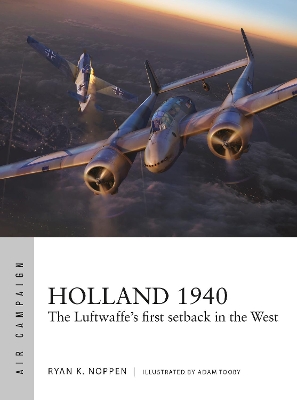Air Campaign
2 total works
In 1940, the strategically vital island of Malta was Britain's last toehold in the central Mediterranean, wreaking havoc among Axis shipping. Launching an air campaign to knock Malta out of the war, first Italy and then Germany sought to force a surrender or reduce the defences enough to allow an invasion. Drawing on original documents, multilingual aviation analyst Ryan Noppen explains how technical and tactical problems caused the original Italian air campaign of 1940-41 to fail, and then how the German intervention came close to knocking Malta out of the war. Using stunning full colour artwork, this fascinating book explains why the attempt by the Axis powers to take the British colony of Malta ultimately failed.
The German invasion of the Netherlands was meant to be a lightning-fast surgical strike, aimed at shoring up the right flank of the assault on France and Belgium. With a bold plan based largely on Luftwaffe air power, air-landing troops, and the biggest airborne assault yet seen, a Dutch surrender was expected within 24 hours.
But the Netherlands possessed Europe's first fully integrated anti-aircraft network, as well as modern and competitive aircraft. On 10 May, the German attack was only partly successful, and the Dutch fought on for another four days. On the fifth day, with its original strategy having largely failed, the Luftwaffe resorted to terror-bombing Rotterdam to force a surrender.
Explaining the technical capabilities and campaign plans of the two sides, and charting how the battles were fought, this fascinating book reassesses this little-known part of World War II. Author Ryan K. Noppen argues that while the Holland campaign was a tactical victory for Germany, the ability of the well-prepared but outnumbered Dutch to inflict heavy losses was a warning of what would come in the Battle of Britain.
But the Netherlands possessed Europe's first fully integrated anti-aircraft network, as well as modern and competitive aircraft. On 10 May, the German attack was only partly successful, and the Dutch fought on for another four days. On the fifth day, with its original strategy having largely failed, the Luftwaffe resorted to terror-bombing Rotterdam to force a surrender.
Explaining the technical capabilities and campaign plans of the two sides, and charting how the battles were fought, this fascinating book reassesses this little-known part of World War II. Author Ryan K. Noppen argues that while the Holland campaign was a tactical victory for Germany, the ability of the well-prepared but outnumbered Dutch to inflict heavy losses was a warning of what would come in the Battle of Britain.

